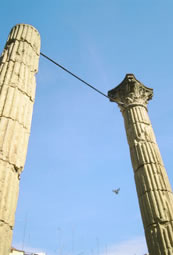
Modernist Heritage
The Modernism designates to Catalonia an extense artistic movement which is developed the last decades of the 19th century and the first of the 20th, and prehave to update the architectural typology and the traditional decorative elements to adapt them into the new techniques, the new industrial materials and the modern sensitivity. It manifests itself like a decorative style based on the asymmetry, the floral ornamentation, the sinuosity and the color. This style coincides with a brilliant period in all Europe - previous to the first world-wide war - where the scientist and technician optimism lives together with the economic prosperity.The Catalan Modernism has an own personality that, in many aspects, is placed in tha avant-garde of its time. It is an artistic movement linked to a political project: the catalanism. The recovery of the language and the own culture, the art, the history and the politics are some of the sides that the modernism helped to promoting. Due to its national character, the Modernism is enriched with numerous references or symbols of its own identity and with the use of forms and ornaments of the Catalan popular art. Simultaneously, this style wants to create a modern culture in tune with the European ordinary ones, attitude that is reflected in the abundant references to the northern architecture and the technological advance in using new materials such as the laminated iron, the industrial glass and the concrete.
In Catalonia, Barcelona is the big center of modernist aqrchitecture, with more of the half 2.000 cataloged works. It is from the brightness of the Barcelona’s movement that style starts to extend the samples along the coast and prelitoral area following the axles of the railway lines. Thus, we find good examples in the local capitals or industrial cities which are around Barcelona, in the summer kernels or spas, in the agricultural regions of the south and in the industrial colonies placed beside the most important rivers.
One of the more distinguished examples of this style in the Costa Daurada is Reus. It was the birth and formation place of the universal architect Antoni Gaudí, and the city where several artists worked. In spite of the linking of Gaudí with its city, the architect Lluís Domènech i Montaner was the one who would leave a stronger imprint in Reus, starting with the construction of the Institut Pere Mata and his following works. At present, it is possible to revive the spirit of 1900 thanks to the Route of the modernism of Reus, admiring the originality of its forms and volumes in the numerous buildings’ façades and discovering the importance of the commercial tradition of Reus, whom was narrowly linked to the modernism. It is necessary to highlight the constructions of the Casa Navàs, the Casa Curl, the Institut Pere Mata, the Xalet Serra or the Oenological Station among others. Tarragona, Tortosa and La Sènia are other cities of the Costa Daurada which had an imported modernist legacy. More of twenty villages and cities own significant examples of this style showing so much religious architecture as civilian one which are designed under the parameters of the sinuous line.
